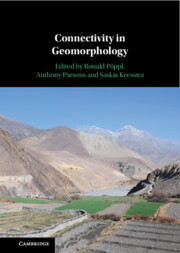Book contents
- Connectivity in Geomorphology
- Connectivity in Geomorphology
- Copyright page
- Contents
- Contributors
- Preface
- Acknowledgements
- Part I Introduction
- Part II Connectivity in Process Domains
- 3 Hillslope Processes
- 4 Fluvial Processes
- 5 Aeolian Processes
- 6 Glacial Processes
- 7 Periglacial Processes
- 8 Coastal and Deltaic Environments
- Part III Quantifying Connectivity in Geomorphology
- Part IV Managing Connectivity
- Index
- References
5 - Aeolian Processes
from Part II - Connectivity in Process Domains
Published online by Cambridge University Press: 10 April 2025
- Connectivity in Geomorphology
- Connectivity in Geomorphology
- Copyright page
- Contents
- Contributors
- Preface
- Acknowledgements
- Part I Introduction
- Part II Connectivity in Process Domains
- 3 Hillslope Processes
- 4 Fluvial Processes
- 5 Aeolian Processes
- 6 Glacial Processes
- 7 Periglacial Processes
- 8 Coastal and Deltaic Environments
- Part III Quantifying Connectivity in Geomorphology
- Part IV Managing Connectivity
- Index
- References
Summary
Wind transports particles by creep, saltation and suspension, of which saltation dominates and is responsible for aeolian landforms. Transported particles generally must go around objects, so that the connectivity defined by the spatial distribution of objects on the surface controls sediment transport. Four spatial and temporal scales of sediment transport are defined. At gap to patch scales, vegetation typically defines the structural connectivity. Vegetation remains important at landscape to basin scales but geomorphic features also contribute to defining transport corridors, or structural connectivity, at the coarsest scale. Patterns of aeolian transport through time are essentially constrained by structural connectivity at multiple, embedded scales. Functional connectivity is not well developed in the aeolian realm and, because particles do not travel more than one or two saltation hops during a single event, functional connectivity is only a relevant concept at the finest spatial scales. Aeolian transport must be approached from the multiple spatial (gap to basin) and temporal (single event to longer periods) scales that define structural and functional connectivity.
Information
- Type
- Chapter
- Information
- Connectivity in Geomorphology , pp. 80 - 101Publisher: Cambridge University PressPrint publication year: 2025
